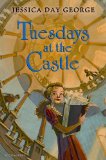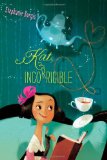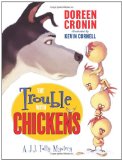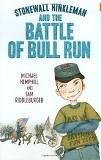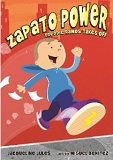 Bigger Than a Bread Box
Bigger Than a Bread Box
by Laurel Snyder
Random House, New York, 2011. 226 pages.
Starred Review
The more I read Laurel Snyder’s work, the more I like what she does! This is a wonderfully written story of a girl dealing with her parents’ divorce. She finds a magic bread box that will grant wishes — as long as the item wished for can fit in the bread box. But of course wanting her parents to get back together doesn’t fit in a bread box.
Now, honestly, this book was painful for me to read, because it’s too soon after my own divorce. It had me crying. I just hate what kids have to go through when their parents divorce, and that got me mad at my husband again for leaving, and that makes me realize I have more forgiveness work to do. It’s one thing to forgive him for what he did to me, but harder to forgive him for what that meant for our kids. But let’s face it. I’m doing great. Yes, my younger son had an especially hard time, but he is doing great now. We just had a wonderful evening together playing a game. Holding a grudge on his behalf will definitely not help things. (Okay, I’m talking to myself now… I digress…)
Anyway, this book doesn’t give generalizations about divorce. It doesn’t preach. But it shows how it feels to one kid in this situation. And you can’t help but notice that her parents aren’t paying a lot of attention to how she feels.
The book starts with Rebecca overhearing a fight when their power went out. This is an efficient way for the author to show us something’s up and what some of the issues are. It works very well, with the viewpoint firmly from Rebecca’s perspective. I like her observation when the power came back on:
“I stood up. I made myself walk. I kept my eyes on my feet. Even so, out of the corner of my eye I could see Mom leaning against the side of the recliner, still wearing her blue scrubs from work, her arms limp and her face all wet. Dad was sitting on the couch, staring past her at the blank TV. He looked sad too, but also, weirdly, he looked a little like he wanted to smile. I guess maybe that was because now everyone knew he had paid the power bill.”
A few days later, on Halloween, her mom takes her two-year-old brother Lew trick-or-treating, and Dad stays home with Rebecca, which is a first. But she doesn’t think much else has changed, except for her dad sleeping on the couch.
Then her mom packs them up in the middle of the week and takes them from Baltimore to Atlanta, where Rebecca’s Gran lives. She doesn’t get to say good-by to her friends, and leaving her dad is awful.
“That was how we left him, through an open car door. My mom stepped on the gas. The car began to move. My dad jumped back to the sidewalk, off balance. When I turned around, I could see him standing in the street. He was calling after us. My dad was yelling in the street for everyone to hear; then he was running behind the car. He was calling, ‘Come back! Come back!'”
When they get to Atlanta, Rebecca learns that her mom has gotten a temporary job and enrolled Rebecca in school. She doesn’t whine about it, but she does get mad. Readers can easily see for themselves that her mom isn’t thinking a whole lot about what this means for Rebecca.
When she goes to the attic to sulk, she finds a collection of bread boxes, and one is bright and shiny. She takes it down to her room and feeling homesick for Baltimore, she wishes there were gulls in Atlanta. And then she hears the cry of a gull — in the bread box!
Naturally (after shooing the two seagulls out the window), she tries out what the bread box can do. It can give her money; it can give her food; it can’t give her things that don’t exist, like a real magic wand, or things that don’t fit in a bread box like wishing she were home.
So Rebecca has to adjust to a new school, where right away everyone calls her Becky. She figures she can be a different person here, someone cool. She has the bread box, after all. She can wish for little gifts for her new friends. She can wish for an ipod and listen to music. She can wish for a little TV and watch shows under the covers.
But magic always has a catch. And when Rebecca finds out what’s really going on with the bread box, it seems like she’s in a worse fix than ever.
This isn’t a problem novel. This isn’t trying to teach anyone how to deal with divorce. But it does tell Rebecca’s story in a tough situation that a lot of kids also have to face. Rebecca has magic to help, but that doesn’t solve the real problems at all.
Now, as I mentioned, I was extra sensitive to this story. I’m afraid I cheered for Rebecca when she finally had her meltdown:
“But Mom didn’t apologize. Instead, in an angry, grown-up voice, she said, ‘I am in charge of this family, young lady, and what I do, I do for you. I only want what’s best for you–‘
“Hearing those words, I didn’t feel bad anymore. I felt justified. ‘That’s a lie,’ I said. My voice was rising, and I couldn’t help it. ‘Because what’s best for me is home, and Dad. Anyone could tell you that, even Gran. But you don’t care about that, not at all. You aren’t thinking about me, or Lew. You’re thinking about yourself, and what you want and what you need.’ I spat this last part in her face. I couldn’t believe I was talking to her this way. I meant to keep my cool, stay calm, but I couldn’t. I forgot about ‘less is more,’ and the words just flew from me like fire — and exploded into loud, angry sounds.”
Now, don’t get me wrong. The author does not present this as the solution to the problem. Like real life, the blow up creates more new problems, including hurting her mom and getting her mom angry. But I wanted it to be said, and I think it does remind her mom that she needs to consider her daughter more than she has been doing. Rebecca also gets new problems when she tries to solve the problems she inadvertently created by using the bread box.
Anyway, I liked it that someone wrote a book from the perspective of a kid caught up in the middle of her parents’ divorce. The feelings ring true. The story is compelling. And it does make you wonder: If you had a magic bread box, what would you wish for?
Buy from Amazon.com
Find this review on Sonderbooks at: www.sonderbooks.com/Childrens_Fiction/bigger_than_a_bread_box.html
Disclosure: I am an Amazon Affiliate, and will earn a small percentage if you order a book on Amazon after clicking through from my site.
Source: This review is based on an Advance Review Copy I picked up at ALA Annual Conference.


